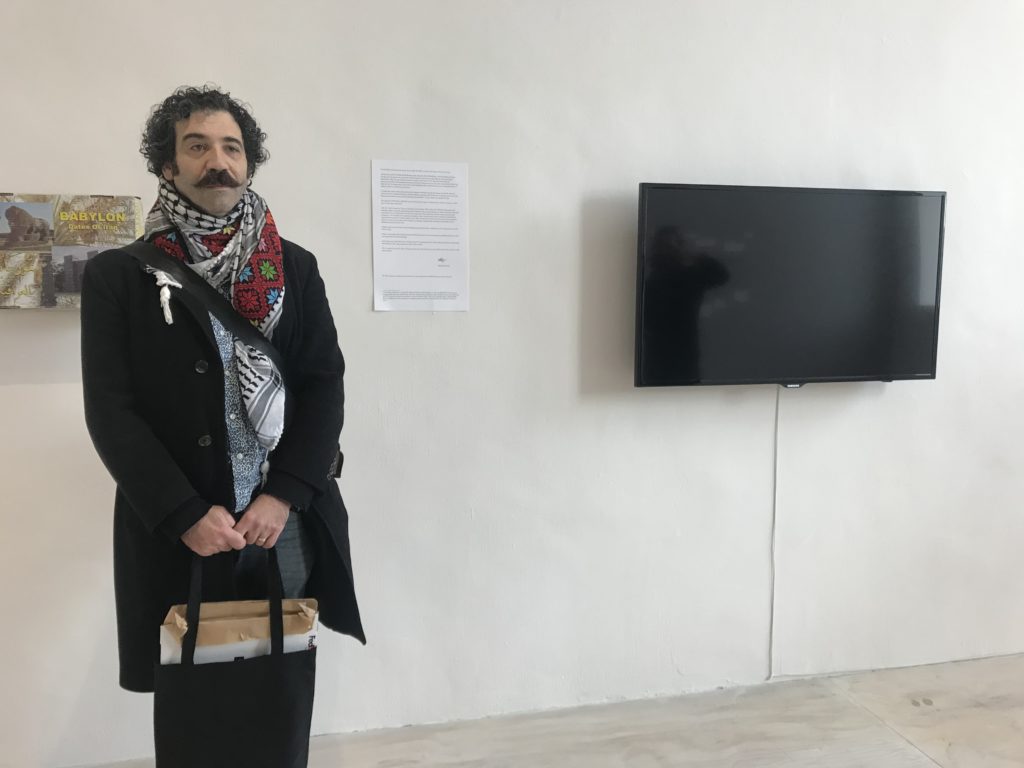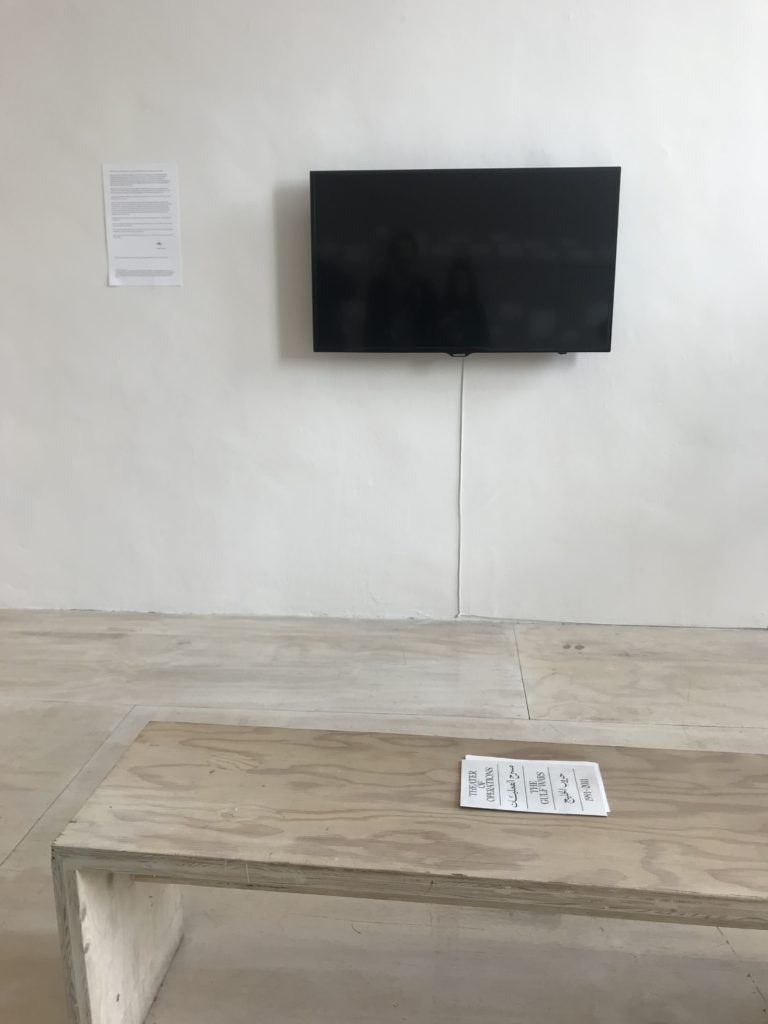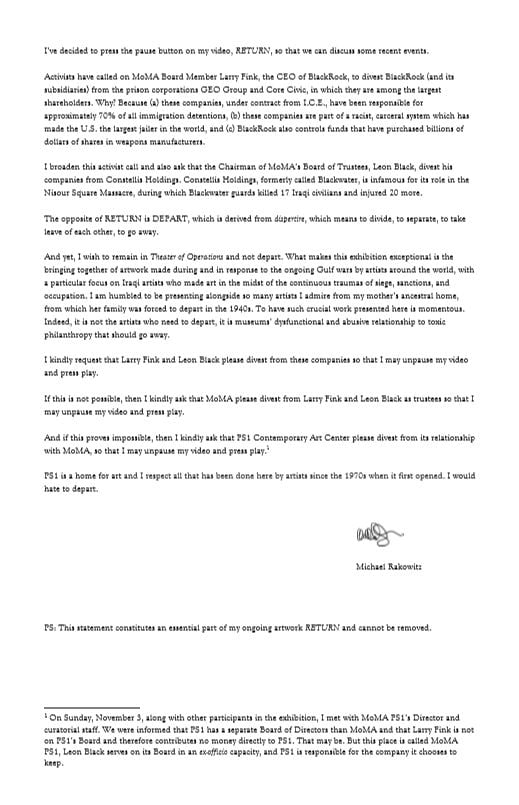Politics
Artist Michael Rakowitz Paused His Video at MoMA PS1 as an Act of Protest. After He Left, the Museum Turned It Back On
This is the latest salvo in an ongoing battle between the artist and institution that has played out since last November.

This is the latest salvo in an ongoing battle between the artist and institution that has played out since last November.

Last November, Michael Rakowitz asked MoMA PS1 to pause a video of his currently on view. The request was made as a gesture of protest against Larry Fink and Leon Black, two board members at the museum’s sister institution in Manhattan, the Museum of Modern Art (MoMA), whom he categorizes as examples of “toxic philanthropy.”
MoMA PS1 never honored Rakowitz’s wishes, though. So on Saturday, the artist showed up to the museum’s exhibition “Theater of Operations: The Gulf Wars 1991-2011,” where the video was on display, to pause it himself. Next to the work, titled RETURN (2004–), he posted a statement explaining why he chose to alter the artwork.
“I’ve decided to press the pause button on my video, RETURN, so that we can discuss some recent events,” Rakowitz’s statement began. The artist then calls on Fink to divest from his company BlackRock, which has come under fire for investing in GEO Group and Core Civic, two companies that own private prisons. It also names Black, whose investment firm Apollo Global has been connected to a defense contractor responsible for killing 17 people at Baghdad’s Nisour Square in 2007.
“I kindly request that Larry Fink and Leon Black please divest from these companies so that I may unpause my video and press play. If this is not possible, then I kindly ask that MoMA please divest from Larry Fink and Leon Black as trustees so that I may unpause my video and press play.”
The story didn’t stop there. After Rakowitz left PS1 Sunday, the museum removed his statement and restarted the video.

Michael Rakowitz’s paused video installation RETURN (2004–) at MoMA PS1. Courtesy of the artist. Photo: Jillian Steinhauer.
“RETURN is an ongoing project and I should have been allowed to update my work,” Rakowitz told Artnet News over email. “The removal of the statement and the museum’s decision to unpause my video damages the work.”
MoMA PS1 has not yet responded to Artnet’s request for comment.
The museum operates under its own board, separate from that of MoMA. PS1 leadership, including director Kate Fowle, chief curator Peter Eleey, and “Theater of Operations” curator Ruba Katrib, reportedly stressed this fact in a meeting with Rakowitz last November. They offered to host an event that would highlight the concerns raised by Rakowitz, but the artist declined, saying he “would be more convinced by a process that involved the communities directly affected by BlackRock, etc.” and still insisting that they pause the artwork.
“I was told by the curators that they wanted to keep the show intact,” Rakowitz recalls of the exchange. “I told the curators and director via email that the posting of my statement, together with the pausing of my video that tells the story of RETURN, is meant to draw attention to a situation that gives me pause as a human and an artist. Given the details that have emerged about MoMA board members being entangled in companies which continue to impact the situation in Iraq, it is appropriate to register this impact within my installation.”
Rakowitz claims that he submitted requests to PS1 to pause his video three separate times and that on each occasion he was told that their position “had not changed.”
“From the inception of this exhibition in 2017, we’ve been fully committed to open communication with artists around the presentation of their work and how to amplify the crucial topics this exhibition explores,” the museum said in a statement to the Art Newspaper in December. “MoMA PS1 is committed to addressing timely issues, and respects the rights of all artists to decide when and where to show their work.”
In 2000, Rakowitz’s first solo project was held in the same room at PS1 where his video is now mounted (a fact that coincidentally adds another layer of meaning to the title of RETURN). That early work, which took the form of a sculpture made from ductwork and fans, adjusted the temperature and relative humidity of the PS1 room. (Having recently been converted from a public school building to an art space, the museum was not yet able to properly regulate its ambient conditions.)
The project “created a safe space for the exhibition of artwork,” says Rakowitz. “Now, unfortunately, this space has been made unsafe. A museum would not compromise the well-being of an artwork. Why, then would it compromise the integrity and well-being of an artist by urging them to exhibit under the auspices and with the funding of people who make conditions unsafe for others?”
Click below to read the artist’s full statement.